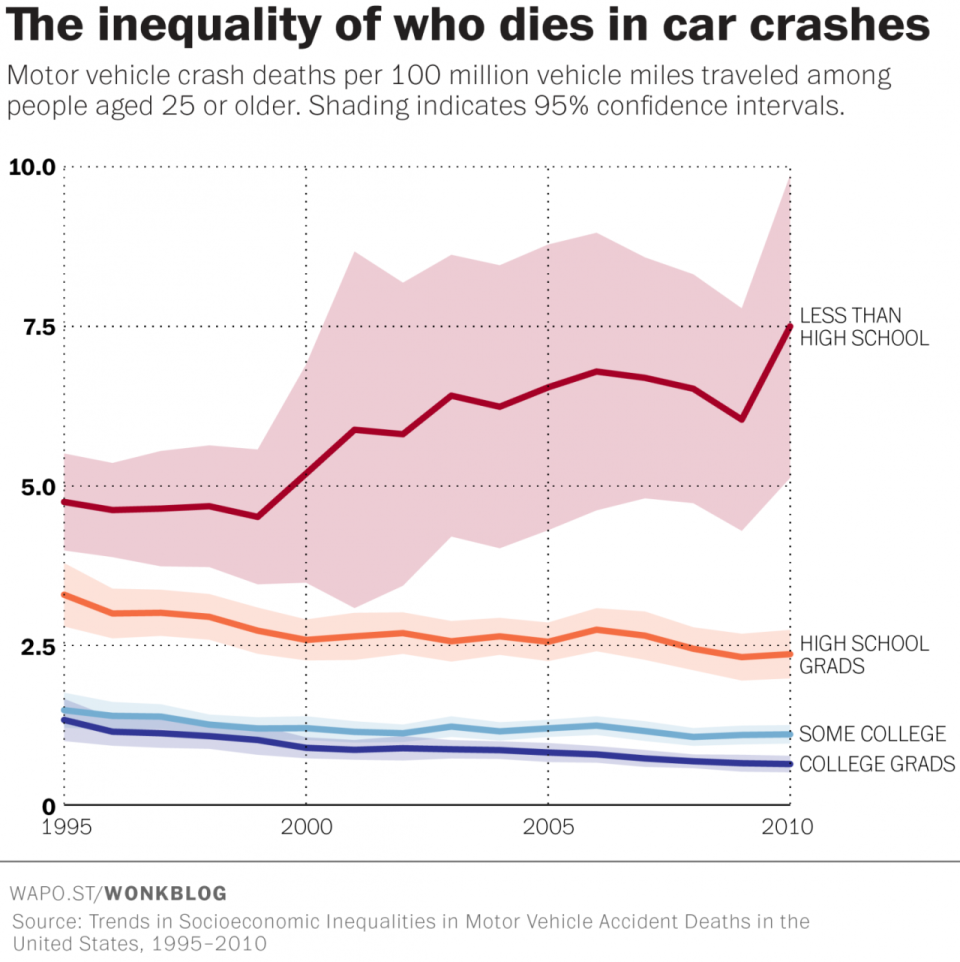Poor People Are More Likely To Die While Driving Than Ever Before

We’re led to believe that traffic fatalities are on the decline, and indeed they are—but only for the well off. New research says that for lower income, less educated individuals, the chance of dying in a vehicular-related incident has actually risen significantly.
The news arrives via the Washington Post, quoting research from the National Center for Health Statistics. That study says that while new technology and better safety standards are keeping some drivers safer, the rich are the only ones benefiting, leaving the poor further at risk than ever before.
It comes as no surprise that the more educated, and likely wealthier you are, the safer you’ll be when driving: Newer, more expensive cars feature better safety technology—like collision warnings that can apply the brakes automatically if a potential accident is detected; lane-assist, pedestrian detection, headlights with better range and even night vision. Those advancements have come faster than ever; you’d be lucky if a 2003 Corolla had anti-lock brakes, and even the basic electronic stability control wasn’t available. Yet that 2003 car is likely still on the road, as the average age of vehicles in use is now a record 11.5 years.
The problem gets compounded further when you think that poor communities likely feature worse roads than affluent communities. And as the Washington Post reports, the residents of these lower income neighborhoods probably have less political sway to implement changes like stop signs, sidewalks and speed bumps, hence pedestrian fatalities are higher in poor areas.

The National Center for Health Statistics’ study looked at all miles traveled between 1995 and 2010, whether in a car, on a bus, a train, a bicycle or even traveling by foot. “In 1995, these death rates — adjusted for age, sex and race — were about 2.5 times higher for people at the bottom of the education spectrum than those at the top,” the Post says. “By 2010, they were about 4.3 times higher. That means the inequality of traffic fatalities is getting worse, even as it looks nationwide as if our roads are getting safer.”
That’s concerning. But why is it happening?
There’s the argument that the uneducated are, in general, less responsible drivers than those with a higher level of education. But that wouldn’t explain why the gap is widening.
According to federal data released in April for the second half of 2013 and the first half of 2014, the wealthiest fifth of Americans increased their income by 0.9 percent, while income of the poorest fifth declined by 3.5 percent. After taxes, the rich did suffer more than those at the bottom of the financial pool, but even still, its not like that fancy Mercedes is causing great concern.
While safety technologies do eventually trickle down to lower-cost vehicles, those struggling financially are not buying new cars and used ones are lasting longer. While the rich are throwing deposits at 2016 Tesla Model Xs, the poor are nursing late 90s Civics. Older studies have found that it can take up to 30 years for a new safety feature to filter across all vehicles; just this year, the penetration rate of cars with front airbags should finally hit 95 percent—even though automakers started installing them during the Reagan administration. Unless something changes, driving while poor may be a risk for many years to come.
Graphic republished courtesy of The Washington Post

 Yahoo Autos
Yahoo Autos 